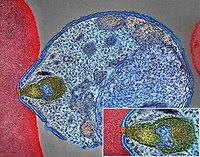
Photo from wikipedia
Abstract Background In sub-Saharan Africa, malaria is frequently overdiagnosed as the cause of an undifferentiated febrile illness, whereas arboviral illnesses are presumed to be underdiagnosed. Methods Sera from 385 febrile… Click to show full abstract
Abstract Background In sub-Saharan Africa, malaria is frequently overdiagnosed as the cause of an undifferentiated febrile illness, whereas arboviral illnesses are presumed to be underdiagnosed. Methods Sera from 385 febrile Kenyan children, who presented to 1 of 4 clinical sites, were tested using microscopy and real-time molecular assays for dengue virus (DENV), chikungunya virus (CHIKV), malaria, and Leptospira. Results Malaria was the primary clinical diagnosis for 254 patients, and an arboviral infection (DENV or CHIKV) was the primary diagnosis for 93 patients. In total, 158 patients (41.0%) had malaria and 32 patients (8.3%) had CHIKV infections. Compared with real-time polymerase chain reaction, microscopy demonstrated a percent positive agreement of 49.7%. The percentage of malaria cases detected by microscopy varied significantly between clinical sites. Arboviral infections were the clinical diagnosis for patients on the Indian Ocean coast (91 of 238, 38.2%) significantly more often than patients in the Lake Victoria region (2 of 145, 1.4%; P < .001). However, detection of CHIKV infections was significantly higher in the Lake Victoria region (19 of 145 [13.1%] vs 13 of 239 [5.4%]; P = .012). Conclusions The clinical diagnosis of patients with an acute febrile illness, even when aided by microscopy, remains inaccurate in malaria-endemic areas, contributing to inappropriate management decisions.
Journal Title: Open Forum Infectious Diseases
Year Published: 2017
Link to full text (if available)
Share on Social Media: Sign Up to like & get
recommendations!